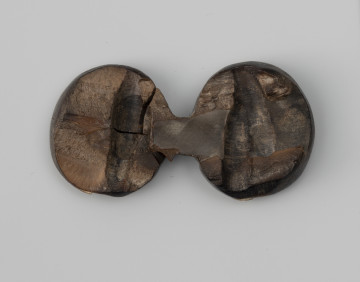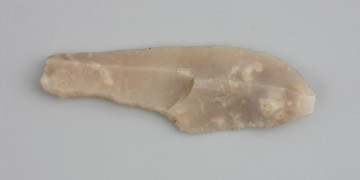
Double button
około 900 p.n.e. — 750 p.n.e.
National Museum in Szczecin
Part of the collection: Bronze Age
This enigmatic small object, formed of a sleeve and four spiked arms, is part of a sizable hoard that also included spiral epaulettes, spearheads and axes. The first mention of the find, discovered while digging peat, made its way into the scientific journal 'Anzeiger für Kunde der deutschen Vorzeit' in 1878, shortly after the unearthing. Thanks to the efforts of a few enlightened people, the metals were handed over in their entirety to the collection of the Szczecin Gesellschaft für Pommersche Geschichte und Altertumskunde (Society of History and Antiquities of Pomerania ). Identification of the objects from the hoard posed virtually no problem from the outset. The only trouble was the peculiar-looking spiked sleeve. At first, it was described simply as an object or device of unknown purpose, but much later more specific terms appeared: barbed clamp, handle or casting waste. However, these were mere conjectures, as there was no foundation of any kind - no other similar finds that would offer a chance to establish the actual function of the object. It took more than 140 years for this undoubtedly intriguing question to be resolved. It was not until 2021, that a letter from Italy was sent to the Department of Archaeology of the National Museum in Szczecin. In it, Dr Francesco Rubat Borel announced that, during research on a pile settlement on Lake Viverone (on the border between the Alps and the Piedmont plain), a bronze bit had been discovered, complete with a rod and two ends identical to the specimen from Babin. This made it clear that the Babin find was the so-called cheekpiece (also known as bit shank), which is one of the ends of the bit, preventing it from moving in the horse's mouth when the reins are pulled back. Both the Italian and Pomeranian discoveries are unique European artefacts, the chronology of which is defined as the turn of the Early Bronze Age, i.e. the years around 1600-1500 BC. Dorota Kozłowska
Other names
Stachelzwinge
Author / creator
Object type
bit ring , bit, halter component (animal equipment), harness component
Technique
casting
Material
bronze
Origin / acquisition method
legal transfer
Creation time / dating
Creation / finding place
Owner
Muzeum Narodowe w Szczecinie
Identification number
Location / status

około 900 p.n.e. — 750 p.n.e.
National Museum in Szczecin

9600 p.n.e. — 4100 p.n.e.
National Museum in Szczecin

11900 p.n.e. — 11000 p.n.e.
National Museum in Szczecin
DISCOVER this TOPIC
National Museum in Lublin
DISCOVER this PATH
Educational path